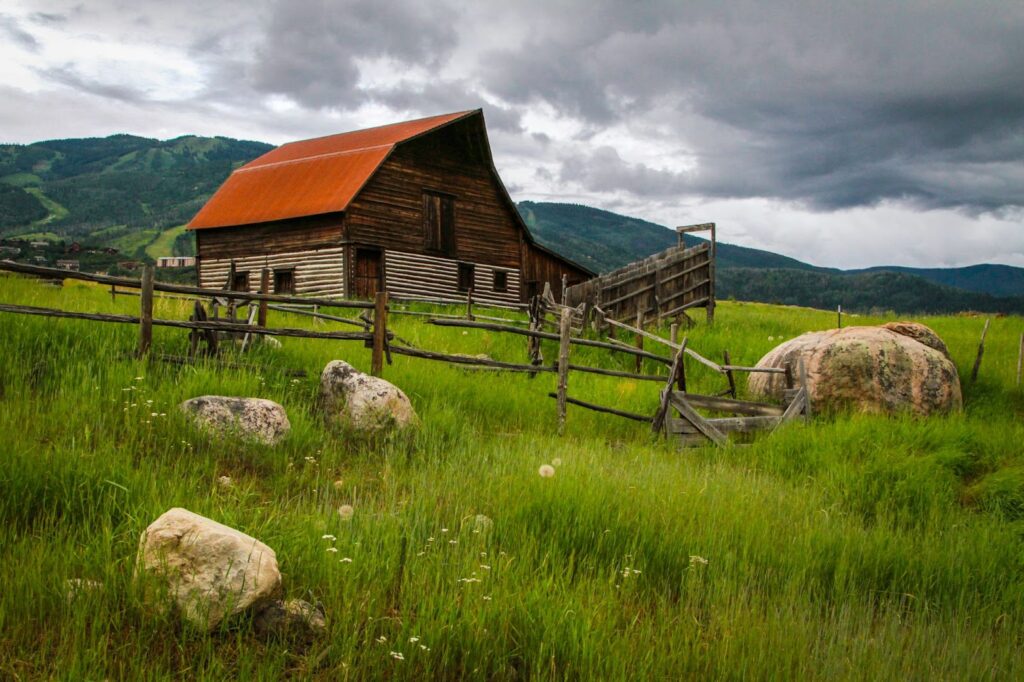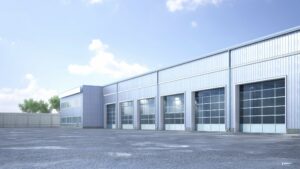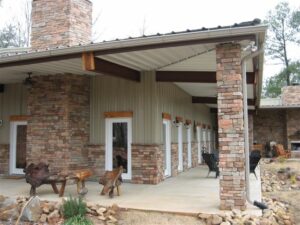Barn roofs are not only vital for safeguarding farm structures from the elements, but they also significantly impact the overall functionality and appearance of the barn. The choice of barn roof types and materials can influence not only its durability and weather resistance but also its visual appeal.
When it comes to barn roof types and materials, there are several factors to consider.
In this article, we will delve into the importance of barn roofing, the different roof types available, and the various materials used in barn roof construction.
Table of Contents:
- Understanding the Importance of Barn Roofing
- An Overview of Barn Roof Types
- Diving into Barn Roofing Materials
- The Lifespan of Different Barn Roofing Materials
- Conclusion
Understanding the Importance of Barn Roofing
Barn roofs play an integral role in farm operations, providing shelter for livestock, storing equipment and supplies, and protecting crops from adverse weather conditions. Additionally, a well-designed barn roof can enhance the overall aesthetic of the farm, adding charm and character to the landscape.
The Role of Barn Roofs in Farm Operations
Barn roofs are not merely protective covers for farm structures; they are critical components that contribute to the efficient functioning of a farm. They provide insulation, preventing extreme temperatures from affecting livestock and stored items.
A well-insulated barn roof helps to maintain a comfortable environment for animals, preventing heat stress in the summer and keeping them warm in the winter.
In addition to insulation, barn roofs also play a crucial role in natural ventilation. Properly designed roofs allow hot air to escape, reducing humidity levels and preventing the buildup of mold and bacteria inside the barn. This is particularly important for the health and well-being of livestock.
Furthermore, barn roofs offer protection against precipitation, such as rain, snow, and hail. By keeping the interior of the barn dry, they prevent damage to equipment, feed, and other stored materials. This helps farmers minimize losses and maintain the quality of their products.
Did You Know?
In 1935, there were 6.8 million farms, most of which had at least one barn. However, by 2007, only about 650,000 of these structures remained. The decline in the number of barns over the years can be linked to various factors, such as urbanization, changes in agricultural practices, and the consolidation of smaller farms into larger operations.
Factors to Consider in Choosing Barn Roof Types and Materials
When selecting the appropriate barn roof type and material, several factors need to be taken into account:
Climate
The climate of the region where the barn is located should be considered. For example, areas with heavy rainfall might require a roof with better water resistance.
Structural Design
The design of the barn itself, including its size, shape, and height, will influence the type of roof that is most suitable.
Budget
Financial considerations are crucial. Different roof types and materials vary in terms of cost, and it’s important to choose an option that fits within the allocated budget.
Maintenance
Some roof types and materials require more maintenance than others. This factor should be taken into consideration, particularly for farmers with limited time and resources.
Moreover, barn roofs can also have an impact on the overall energy efficiency of a farm. By choosing the right roofing materials, farmers can reduce their energy consumption and lower their carbon footprint.
For example, metal roofs are known for their reflective properties, which help to reduce heat absorption and keep the barn cooler during hot summer months. This not only benefits the animals but also reduces the need for additional cooling systems, saving energy and reducing costs.
Another important consideration when it comes to barn roofs is their durability. Farm structures are exposed to various weather conditions and need to withstand the test of time. Investing in high-quality roofing materials can ensure that the barn roof remains intact and provides reliable protection for many years to come.
Additionally, some roofing materials, such as metal or tile, offer excellent resistance against fire, providing an added layer of safety for the farm and its inhabitants.
Roofs are not just functional components of a farm; they are essential elements that contribute to the overall success and well-being of the operation. From insulation and ventilation to protection against the elements, choosing the right barn roof type and material is crucial.
By considering factors such as climate, structural design, budget, and maintenance requirements, farmers can make informed decisions that will benefit their farms in the long run.
An Overview of Barn Roof Types
When it comes to barns, choosing the right roof type is essential. Not only does it affect the overall aesthetic appeal, but it also plays a crucial role in protecting the structure from the elements. Let’s take a closer look at some of the most popular barn roof types and their unique characteristics.
Gable Roofs
Gable roofs are the go-to choice for many barn owners, and it’s not hard to see why. With their classic triangular shape, gable roofs offer simplicity and efficiency in shedding water and snow.
The high peaks of gable roofs also provide excellent ventilation, making them an excellent option for farms located in hot and humid climates. Imagine the cool breeze gently flowing through the barn, keeping the animals comfortable even on scorching summer days.
Gambrel Roofs
If you’re looking for a roof style that combines functionality with a touch of traditional charm, gambrel roofs are the way to go. Also known as barn-style roofs, gambrel roofs feature two slopes on each side, with the lower slope being steeper than the upper slope.
This unique design not only adds visual interest but also provides extra space in the upper portion of the barn. Imagine having a spacious loft area where you can store hay or even convert it into cozy living quarters. Gambrel roofs are a perfect blend of practicality and versatility.
Hip Roofs
When it comes to stability and durability, hip roofs are second to none. Characterized by their four sloping sides that converge to form a ridge at the top, hip roofs offer excellent resistance against high winds.
This makes them an ideal choice for barns located in areas prone to strong gusts. But that’s not all — the inclined sides of a hip roof also provide additional shaded areas around the barn. This not only protects the structure from direct sunlight but also creates a pleasant environment for the animals to relax and escape the scorching heat.
Shed Roofs
For those looking for simplicity and cost-effectiveness, shed roofs are the answer. These single-slope roofs are easy to construct and are commonly used for small barns or storage sheds. Shed roofs are particularly popular in areas with low precipitation, where minimal water runoff is needed.
However, it’s important to consider the climate carefully, as shed roofs may not provide adequate protection in regions with heavy rainfall. Proper planning and maintenance are key to ensuring the longevity of a shed roof.
So, whether you’re aiming for a classic look, extra storage space, enhanced stability, or simplicity, there’s a barn roof type that suits your needs. Take the time to consider the specific requirements of your barn and choose a roof that not only complements its design but also provides the functionality and protection you desire.
After all, a well-designed barn roof is not just a practical necessity but also a beautiful addition to any farm landscape.
Pro tip:
The gable roof is the most common style used in barns, but other styles such as the gambrel roof and hip roof are also popular, depending on the specific needs and preferences of the barn owners. The gambrel roof, with its two slopes on each side, offers better storage space and headroom, making it ideal for two-story barns. The hip roof, with slopes on all four sides, is less common but provides stability and durability.
Diving into Barn Roofing Materials
Once you have determined the type of barn roof that suits your needs, it is time to consider the materials to be used.
Choosing the right roofing material for your barn is essential, as it not only affects the overall appearance but also determines the level of protection and longevity.
Let’s explore some additional details about the different roofing materials available:
Metal Roofing
Metal roofing offers durability, longevity, and low maintenance requirements. It is resistant to fire, insects, and rot, making it a popular choice for barn roofs. Metal roofing is available in various colors and finishes, allowing farmers to choose a style that complements the overall appearance of their farm.
Moreover, metal roofs are known for their energy efficiency. They reflect sunlight, reducing the heat absorbed by the barn and helping to keep the interior cool during hot summer months. This can lead to significant energy savings and a more comfortable environment for livestock or storage.
Did You Know?
Metal roofs are typically made from steel, aluminum, zinc, copper, or tin, and can withstand extreme weather conditions, including heavy snow, intense summer heat, and high winds of up to 140 mph.
Asphalt Shingles
Asphalt shingles are a cost-effective and widely used roofing material for barns. They are available in a range of colors and styles, providing flexibility in design. Asphalt shingles offer good protection against the elements and are relatively easy to install and maintain.
However, their durability and lifespan may be shorter compared to other roofing materials.
One advantage of asphalt shingles is their versatility. They can be designed to mimic the appearance of other roofing materials, such as wood or slate, giving your barn a more upscale look without the high cost.
Additionally, asphalt shingles are lightweight, which reduces the load on the barn’s structure.
Wood Shingles and Shakes
Wood shingles and shakes provide a traditional and rustic look to barn roofs. They offer good insulation and natural ventilation. Wood shingles are machine-cut, while shakes are hand-split, resulting in a slightly different appearance.
However, wood roofing materials require regular maintenance and treatment to prevent decay and insect damage.
When properly cared for, wood shingles and shakes can last for decades, adding character and charm to your barn. They age beautifully, developing a weathered patina that enhances the rustic appeal.
It’s important to note that some local building codes may restrict the use of wood roofing materials due to fire safety concerns, so be sure to check with your local authorities before making a decision.
Clay and Concrete Tiles
Clay and concrete tiles are known for their durability and aesthetic appeal. They are available in various shapes, sizes, and colors, allowing for customization. Tile roofs offer excellent resistance to fire, extreme weather conditions, and pests. However, they are heavier and may require additional structural support for the barn.
One of the standout features of clay and concrete tiles is their longevity. With proper installation and maintenance, these roofs can last for over fifty years, making them a long-term investment. Additionally, the distinct architectural style of tile roofs adds a touch of elegance and sophistication to any barn, making it stand out in the countryside.
By considering the various roofing materials available, you can make an informed decision that suits your barn’s needs and enhances its overall aesthetic appeal. Remember to take into account factors such as climate, budget, and local regulations to ensure the best choice for your barn’s roof.
Pro tip
To maximize the longevity and performance of clay and concrete roof tiles, it’s crucial to ensure they are installed by a professional roofer who follows the manufacturer’s guidelines. Proper installation includes using the right underlayment, flashing, and fastening methods.

The Lifespan of Different Barn Roofing Materials
The lifespan of barn roofing materials varies depending on several factors, including the quality of materials, installation techniques, and maintenance practices.
Durability of Metal Roofs
Metal roofs have the longest lifespan among barn roofing materials. Properly installed and well-maintained metal roofs can last for fifty years or more.
They offer exceptional resistance to fire, rot, and insects, making them an excellent long-term investment for farmers.
Lifespan of Asphalt Shingles
Asphalt shingles typically have a lifespan of fifteen to thirty years. While they are a cost-effective option, they are more susceptible to damage from high winds, hail, and extreme temperature fluctuations.
Regular inspection and maintenance can help prolong the lifespan of asphalt shingles.
Longevity of Wood Shingles and Shakes
Wood shingles and shakes can last for twenty to forty years when properly maintained. Regular cleaning, treatment, and prompt repairs are essential to prevent decay and insect infestation.
Additionally, periodic inspections can help identify any issues early on and extend the lifespan of wood roofing materials.
Endurance of Clay and Concrete Tiles
Clay and concrete tiles have an impressive lifespan of fifty to one hundred years when installed correctly. They are known for their durability and ability to withstand harsh weather conditions. However, their weight and fragility may pose challenges during installation and maintenance.

Conclusion
In conclusion, barn roof types and materials play a crucial role in the overall functionality, durability, and aesthetic appeal of farm structures. When choosing a barn roof, it is important to consider factors such as climate, structural design, budget, and maintenance requirements.
The different roof types, including gable, gambrel, hip, and shed roofs, offer unique advantages depending on specific needs and preferences.
Additionally, the choice of roofing material, such as metal, asphalt shingles, wood shingles, and clay/concrete tiles, influences the lifespan and maintenance requirements of the barn roof.
By carefully considering these factors, farmers can make informed decisions to ensure their barn roofs provide long-lasting protection and enhance the overall appearance of their farms.
SteelCo has more than 23 years of experience in dropshipping customizable steel building kits for building and roofing needs nationwide. Our team of experts with 100+ years combined experience can provide specialized assistance in helping clients with concept/design, navigating construction timelines, and providing stamped engineering plans to simplify the process of obtaining necessary building permits and licenses. Learn more about our steel agricultural buildings or barndominiums.
—————————-
Check out these related articles:
> A Guide To Metal Horse Barns
> Pole Barn Vs Metal Building: A Comparative Guide
> Are Barndominiums Safe In Severe Weather? Exploring The Storm-Resistant Nature Of Modern Barn Homes
























